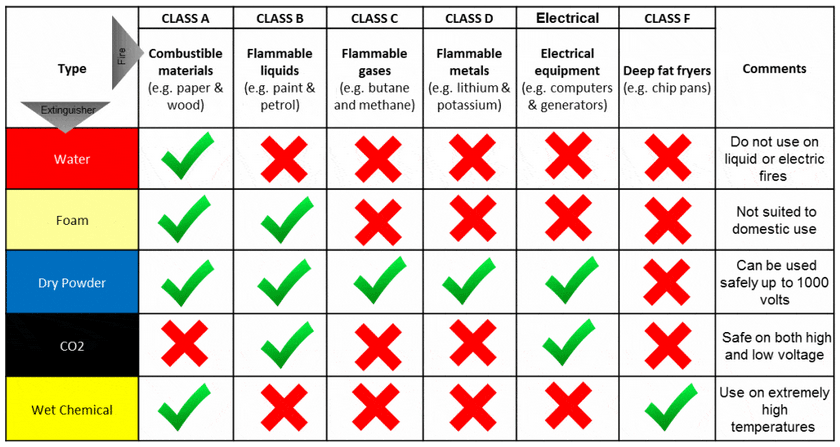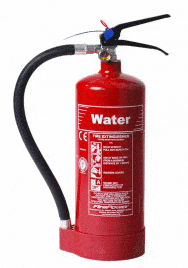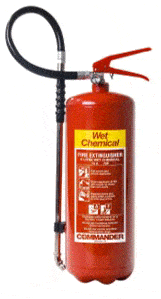5 types of common fire extinguishers today
There are 5 main types of fire extinguishers - Water, Foam, Dry Powder, CO2 and Wet Chemical. What are the uses? Which fire to use? with features related to fire safety
- You should choose and use appropriate fire extinguishers for your facility, but you must also comply with current regulations of the Fire Department. So what are the 5 common types of fire extinguishers today? Please refer to after this article. - Different types of fire extinguishers are used to put out fires using different types of fuel - these are called 'types' of fires. The fire risk from different types of fires in your business will determine what type of fire extinguisher you need and have.
- ABC powder fire extinguisher
- Co2 fire extinguisher
- Foam fire extinguisher -
Water fire extinguisher - Wet chemical fire extinguisher - What are the fire classes of the 5 common types of fire extinguishers today?
- There are six fire classes: Class A, Class B, Class C, Class D, 'Electrical' and Class F. -
- Class A fires - combustible materials: caused by flammable solids, such as wood, paper and fabric
- Class B fires - flammable liquids: such as gasoline, turpentine or paint
- Class C fires - flammable gases: such as hydrogen, butane or methane - Class D fire - flammable metals: chemicals such as magnesium, aluminum or potassium
- Electrical fire - electrical equipment: after removing electrical items, the fire will escalate
- Class F fire - cooking oil: typically a cooking oil pan fire

Instructions for use of fire extinguishers appropriate to the fire fighting class
>>> HOW TO USE POWDER FIRE EXTINGUISHERS SAFELY >>>>
Below we will learn in detail the overview of uses, forms, and instructions for use of 5 common types of fire extinguishers today.

Bình chữa cháy nước
.gif)
Overview: - Foam fire extinguishers are the most common type of fire extinguisher for Class B fires, but are also effective on Class A fires because they are water-based. Label color: - Cream Use for: - Organic materials such as:
o Paper and cardboard
o Fabrics and textiles
o Wood and charcoal In addition:
- Flammable liquids, such as paint and gasoline Do not use for:
- Kitchen fire
- Fires related to electrical equipment
- Flammable metal How foam fire extinguishers work: Like water fire extinguishers, foam fire extinguishers have the effect of cooling the fuel. On the burning liquid, the foaming agent creates a barrier between the flame and the fuel, extinguishing the fire. Types of establishments/businesses that may require Foam Fire Extinguishers:
- Buildings constructed of wood or other organic materials - Sites where organic materials are found such as:
o Office o School
o Hospital
o Residential area
o Warehouse - Buildings where flammable liquids are stored In fact, most buildings require water or foam fire extinguishers Location of foam fire extinguisher:
- Follow emergency exits on floors where a Class A or Class B fire hazard has been identified
3.Dry powder fire extinguisher

Bình chữa cháy bột khô
Overview: Standard dry powder fire extinguishers are also known as 'ABC' fire extinguishers as they tackle Class A, B and C fires, however, they are not recommended for use in enclosed spaces. This is because the powder can be easily inhaled, and the residue is also difficult to clean off afterwards. ABC powder fire extinguishers can also be used on some electrical fires. Dry powder fire extinguishers are specialized for flammable metals. Label color: - Blue Use for: - Organic materials such as: o Paper and cardboard o Fabrics and textiles o Wood and charcoal Plus: - Flammable liquids, like paint and gasoline. related to electrical equipment up to 1000v - Specialized dry powder fire extinguishers are for use only on combustible metals, such as titanium and magnesium. Do not use for: - Fires related to cooking oil
- Fires involving electrical equipment above 1000v - or in enclosed spaces, such as offices or residential properties How dry powder fire extinguishers work: Dry powder fire extinguishers extinguish fires by forming a barrier between the fuel and the oxygen source. Types of premises/businesses that may need dry powder fire extinguishers:
- Business establishments using flammable gases for chemical processes
- The premises where the flame welding and cutting process takes place - Garage
- Liquid Petroleum Gas (LPG) Processing Plant
- Premises with large commercial boiler rooms Location of dry powder fire extinguisher:
- Place dry powder fire extinguishers near sources of fire risk. Specialized dry powder fire extinguishers - what is the difference?: Specialized dry powder fire extinguishers work like standard dry powder fire extinguishers but are only for use on combustible metals. There are 2 specialist types of dry powder fire extinguishers - 'L2' which only tackles lithium fires, and 'M28', which is for all other combustible metal fires.
4. Carbon Dioxide (CO2) fire extinguisher
.gif)
Bình chữa cháy Carbon Dioxide (CO2)
Overview: CO2 fire extinguishers are primarily used for electrical fire risks and are often the main type of fire extinguisher provided in computer rooms. They also extinguish Class B fires (flammable liquids, such as paint and petroleum). Label color: - Black Use for: - Flammable liquids, such as paint and gasoline - Electrical Fire Do not use for: - Kitchen fires - especially chip pan fires - Flammable materials such as paper, wood or textiles - Flammable metal How CO2 fire extinguishers work: CO2 fire extinguishers suffocate a fire by displacing the oxygen the fire needs to burn. Types of premises/businesses that may need CO2 fire extinguishers: - Premises with electrical equipment, such as: o Office o Kitchen o Construction site o Server room All work vehicles should also carry a CO2 fire extinguisher smaller than 2kg. Location of CO2 fire extinguisher: - Place near sources of fire hazard and/or near emergency exits.
5. Wet chemical fire extinguisher

Bình chữa cháy hóa chất ướt
Overview: Wet chemical fire extinguishers are designed for use on Class F fires, involving cooking oils and fats. They can also be used in Class A fires although it is more common to have foam or water extinguishers for this type of fire hazard. Label color: - Yellow Use for: - Fires caused by cooking oil/fat - Organic materials such as: o Paper and cardboard o Fabrics and textiles o Wood and charcoal Do not use for: - Flammable liquid or gas fires - Electrical fire - Flammable metal How wet chemical fire extinguishers work: Wet chemical fire extinguishers create a layer of foam on the surface of the burning oil or fat, preventing oxygen from fueling the fire. The spray also has a cooling effect. Types of establishments/businesses that may need wet chemical fire extinguishers: - Commercial kitchen - Canteen Location of wet chemical fire extinguisher: - Place near sources of fire risk. In summary: the article 5 common types of fire extinguishers today that we share in our opinion can help you better understand the types of fire extinguishers today. Please leave your comments to help us improve our technical articles. Thank you very much.
>>>>> Where to buy fire extinguishers in Ho Chi Minh City at good prices >>>>>

Have 0 comment, evaluate about 5 types of common fire extinguishers today
TVAdministratorsAdministrators
Welcome, honored guests. Please leave a comment, we will respond soon